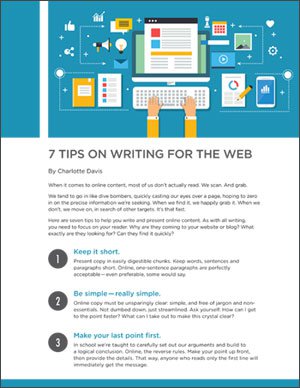7 Tips on Writing for the Web
Sept. 5, 2017

When it comes to online content, most of us don’t actually read. We scan. And grab.
We tend to go in like dive bombers, quickly casting our eyes over a page, hoping to zero in on the precise information we’re seeking. When we find it, we happily grab it. When we don’t, we move on, in search of other targets. It’s that fast.
Here are seven tips to help you write and present online content. As with all writing, you need to focus on your reader. Why are they coming to your website or blog? What exactly are they looking for? Can they find it quickly?
1. Keep it short.
Present copy in easily digestible chunks. Keep words, sentences and paragraphs short. Online, one-sentence paragraphs are perfectly acceptable — even preferable, some would say.
2. Be simple — really simple.
Online copy must be unsparingly clear: simple, and free of jargon and nonessentials. Not dumbed down, just streamlined. Ask yourself: How can I get to the point faster? What can I take out to make this crystal clear?
3. Make your last point first.
In school we’re taught to carefully set out our arguments and build to a logical conclusion. Online, the reverse rules. Make your point up front, then provide the details. That way, anyone who reads only the first line will immediately get the message.
4. Use headings and sub-headings — and make them count.
Headings and sub-headings act as anchor points, helping the reader navigate her way through the text. The trick is to make meaning. Rather than the generic “About Company ABC,” for example, tell the reader what you want them to know: “Company ABC — The world’s leading widget maker.” Even if the reader only scans and grabs the headings, they will still come away with substantive information.
5. Use numbered lists and bullets.
Lists and bullets make it easier for the reader to scan. They also give structure to your writing and stop you from waffling. As an added bonus, they help you tick the box for point No. 3: With a list, you’re forced to make your point first, then elaborate below.
6. Be bold.
Using bold text is another way to ensure that certain phrases will stand out. This is especially helpful if you do happen to have a longer paragraph or block of text.
7. Use links generously.
As with bolding, the eye is naturally drawn to hyperlinks. And, importantly, linking to other pages on your website keeps readers on your site and engaged longer.
Whether you’re writing for print or for web, isn’t that what it’s all about? Grabbing hold of your reader and keeping their attention by clearly and consistently delivering the information they need.
Download article in PDF format
Writing Tips & Tools
